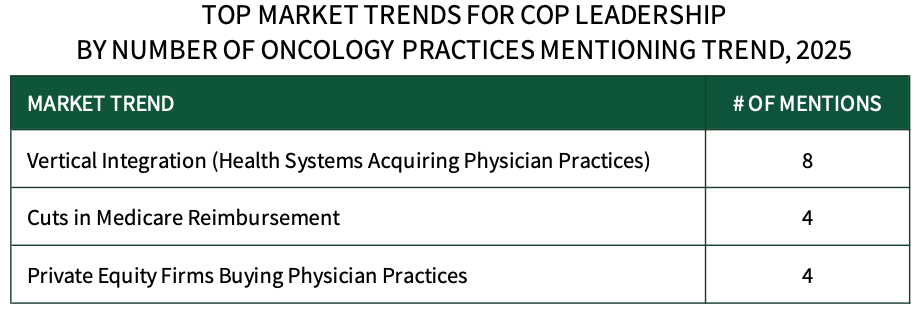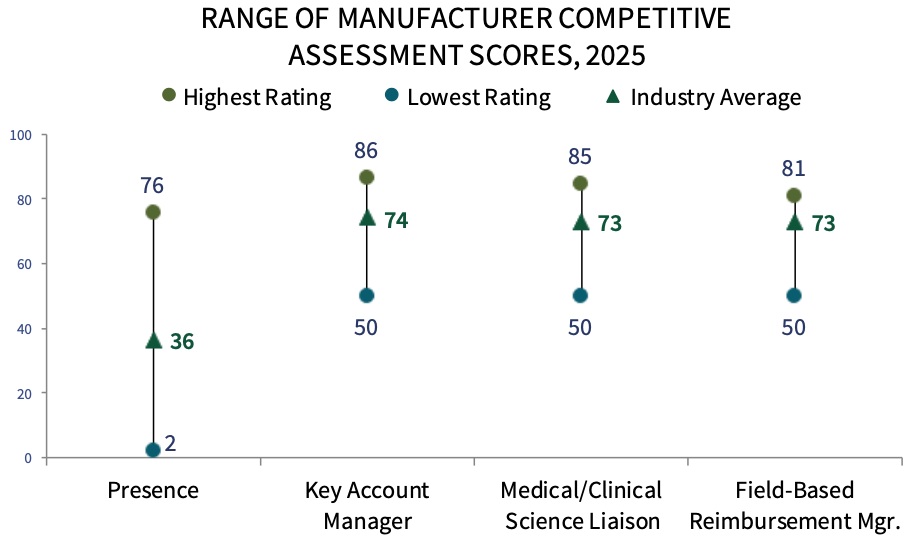Community Oncology Practices: Market Trends and Manufacturer Competitive Assessment
Highlights of the report:
Download a PDF of these Highlights
In response to declining reimbursement and other market changes, community oncology practices (COPs) are strategically focusing on enhancing their practices' competitiveness and strengthening their market positions and brand equity. HIRC's report, Community Oncology Practices: Market Trends and Manufacturer Competitive Assessment, reviews COPs' needs, challenges, and concerns, top strategic imperatives for 2025, and provides an assessment of manufacturer engagement. The report addresses the following questions:
- What are COPs' top market concerns and strategic priorities in 2025? How are COPs impacted by trends such as the Inflation Reduction Act, novel bispecific therapies, and private equity M&A in 2025?
- What is the status of COP activity related to oncology pharmacy and dispensing services (e.g., alternate site infusion, specialty pharmacy, etc.)?
- What is the status of oncology preferred drug lists, clinical pathways, and other utilization management tactics?
- Which manufacturers are most often nominated as COPs' partner of choice? Which firms provide the best oncology-related support offerings?
- How do pharmaceutical firms benchmark in account engagement and quality of oncology account managers, medical/clinical science liaisons, and field-based reimbursement managers?
Key Finding: A number of market dynamics are poised to impact oncology medication market access in the community oncology practice sector, such as vertical and private equity M&A, cost & reimbursement pressure, and PDLs that favor oncology biosimilars.
Top Market Trends for Community Oncology Practices in 2025. Community oncology practice respondents identify a number of market trends with the potential to impact their organizations, including (1) vertical integration (health systems acquiring physician practices), (2) cuts in Medicare reimbursement, and (3) private equity firms buying physician practices.

The full report provides the complete listing of 50+ trends identified by oncology practices, as well as their top strategic priorities for the next 12-18 months.
COPs Most Frequently Designate Preferred Products in Categories with Oncology Biosimilars. Panelists were asked to indicate whether their practice designates any oncology medications as preferred across eight medication types. About 87% of COP decision-makers report having preferred oncology biosimilar products in place in 2025, 62% report preferences in IV conventional chemotherapy, and 56% in IV targeted therapy products. The full report examines biosimilars in detail, including which are preferred and how COPs promote their use.

Pharmaceutical Manufacturer Competitive Assessment COP respondents were asked to evaluate manufacturer customer-facing personnel, such as oncology account managers, medical/clinical science liaisons, and field-based reimbursement managers. Genentech, Pfizer Oncology, and Merck Oncology rate highest in manufacturer field personnel engagement. The complete report provides COP executives' ratings of 30+ firms active in oncology, as well as ratings of manufacturers' oncology-related support offerings and nominations for overall partner of choice.

Research Methodology and Report Availability. In January HIRC surveyed 45 executives from community oncology practices. Online surveys and follow-up telephone interviews were used to gather information. The full report, Community Oncology Practices: Market Trends and Manufacturer Competitive Assessment, is available now to HIRC’s Managed Oncology subscribers at www.hirc.com.
Download a PDF of these Highlights
Download Full Report (Subscribers only) >

